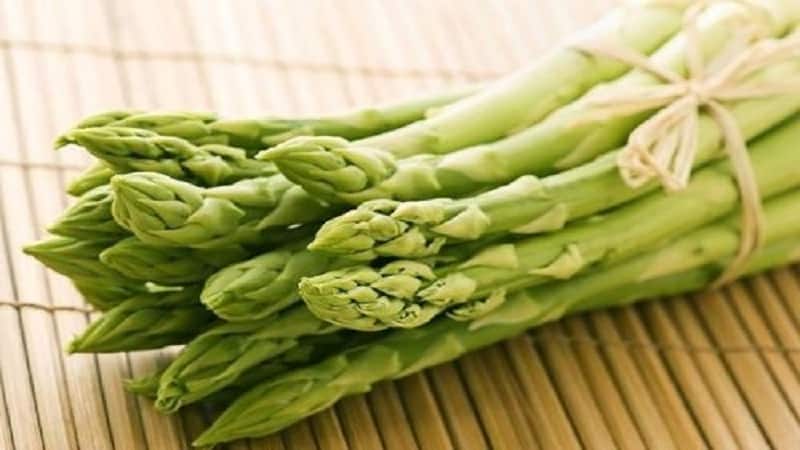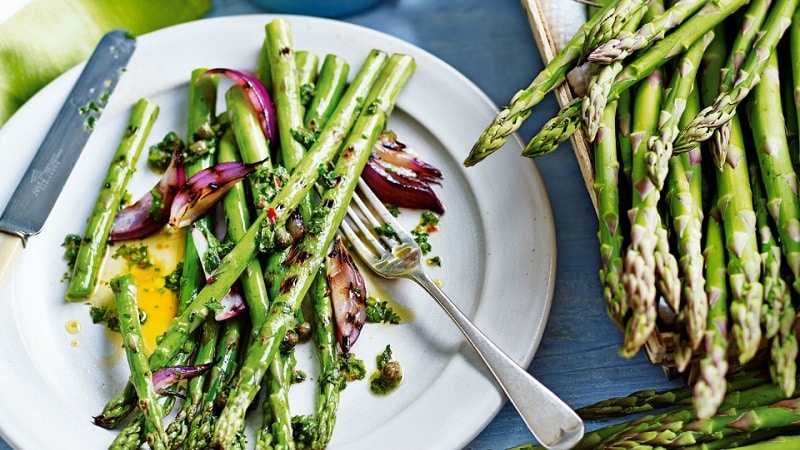The benefits of pickled asparagus and how to cook it at home
Many people confuse stem asparagus and a soybean semi-finished product called fuju. In fact, these are two completely different products, but equally useful. They are widely used in cooking to prepare a variety of salads and snacks.
Green asparagus, or asparagus, is pickled for the winter, steamed and baked, and the soy product is used to make savory snacks. In this article you will learn about the fundamental differences between products, nutritional value and cooking methods.
Pickled soy and green asparagus
Green asparagus, or asparagus, and soy asparagus (fuju) are used in cooking. - semi-finished product made in Korea. In Russia there is a misconception that these two products are no different. One type is green, the other is white. In fact, there is a difference.

Asparagus has many varieties and subspecies. Most often, ordinary green or white asparagus is used for food. Only the tops of the plant with small buds are edible. The stems are highly valued for their chemical composition and medicinal properties.
Fuzhu is made from soybeans, which are pre-soaked in water for a long time, crushed to a homogeneous consistency and milk is extracted from this mass. Then it is boiled and the foam is skimmed off, which is then dried. This product is used to prepare Korean salads.
Asparagus and fuju are prepared with various additives in the form of spices, poured with aromatic marinade.
Read also:
What is asparagus, what does it look like and how is it used?
What is asparagus good for weight loss and how to eat it correctly
Chemical composition and nutritional value
Pickled ordinary asparagus contains useful components such as:
- vitamins A, B1, B2, B9, C, E, H, PP, K;
- minerals (potassium, iron, magnesium, calcium, phosphorus, sodium, zinc);
- natural organic compounds (coumarins, saponins).
Nutritional value of the plant:
- fresh calorie content – 20 kcal per 100g;
- proteins – 1.9 g;
- fats – 0.1 g;
- carbohydrates – 3.1 g.
Soy asparagus contains the following set of components:
- vitamins A, B1, B2, B5, B6, B9, B12, C, PP;
- minerals (potassium, phosphorus, magnesium, zinc, selenium, calcium, manganese, iron, copper, sodium).
The nutritional value:
- dry calorie content – 440 kcal;
- proteins – 45 g;
- fats – 20 g;
- carbohydrates – 20 g.
Reference. After soaking, the calorie content of soy asparagus is halved.

Harm and benefit
Pickled Green Asparagus is High in Dietary Fiber, which stimulate the smooth muscles of the intestines and improve the functioning of the entire digestive tract. Vitamins stop the development of atherosclerosis, normalize metabolism, increase immunity and fight free radicals, reducing the risk of cancer.
Coumarins stimulate the work of the heart muscle, cleanse the blood and improve clotting. Saponins have anti-inflammatory, diuretic and anti-sclerotic effects on the body. Asparagus is considered a powerful aphrodisiac that increases libido in men and women.
Despite the obvious benefits, the plant can have a negative impact on well-being.. The same saponins cause severe irritation of the gastric mucosa, which is why asparagus is on the list of prohibited foods for gastritis.In some cases it causes allergic reactions.
Fuzhu claims the title of "elixir of youth" thanks to plant protein, which is completely absorbed by the body. Soy asparagus is used as a means to prevent pathologies of blood vessels and heart. Antioxidant action reduces the risk of developing cancer. The product does not contain cholesterol and lactose, so it is suitable for people with diabetes and allergies.
Negative effects of the product on the human body is the risk of disruption of the pancreas and thyroid glands, gastrointestinal tract, and genitourinary system.
Reference. Soy asparagus is an excellent replacement for animal protein. The product is recommended to be included in the diet of athletes and vegetarians.
How to pickle asparagus at home
Nutritionists recommend consuming asparagus baked, boiled, fried and pickled.. The product is subjected to minimal heat treatment to preserve taste and the full range of nutrients.
It is very important not to overcook the sprouts and cook until al dente (to the bite). To preserve asparagus for the winter, it is sealed in jars and filled with a marinade based on water, vinegar, salt and aromatic spices.
Fuzhu for cooking at home pre-soak in warm water, since the product is commercially available in dry form. Salads with carrots, garlic and other vegetables are prepared from soy asparagus. Add spices, soy sauce and vinegar.
This is interesting:
The benefits and harms of boiled beets
Best Recipes
We have prepared for you several popular recipes for cooking fuju and asparagus. Adjust the amount of vinegar, sugar and salt based on your own preferences. You can add any spices to your snacks to suit your taste.
Classic soy asparagus recipe
Ingredients:
- fuzhu – 200 g;
- garlic – 5 cloves;
- corn oil – 6 tbsp., l.;
- vinegar 9% - 1 tbsp., l.;
- rock salt – 1 tbsp., l.;
- soy sauce – 1 tbsp., l.;
- sugar - half a tablespoon;
- red pepper to taste.

Soak soybean asparagus in water room temperature for 24 hours. During this time, she will have time to soften. Cut into desired size pieces.
Pass the peeled garlic through a press and stir in salt, sugar, vinegar, soy sauce and oil.
Pour marinade for soy asparagus, add pepper and stir. Place in a container with an airtight lid and refrigerate for 10-12 hours to marinate.
Advice. Choose soy sauce that contains only soybeans and salt, without flavor stabilizers or preservatives.
Marinated fuju with paprika
Ingredients:
- soy asparagus – 250 g;
- carrots – 1 pc.;
- paprika – 1 pc.;
- onion – 1 pc.;
- oil – 50 ml;
- soy sauce, red pepper, ground ginger - to taste;
- garlic – 3 cloves.
Cut the soaked fuju into pieces. Chop the carrots into thin long strips, cut the onion into half rings and fry in oil. Then add asparagus and sweet pepper cut into strips. Simmer in a frying pan for 5-7 minutes. Season with soy sauce, garlic and spices passed through a press.
Soy asparagus with carrots “Korean style”
Ingredients:
- fuzhu – 300 g;
- two medium-sized carrots;
- garlic – 3 cloves;
- sesame oil – 120 ml;
- salt – 1 tbsp., l.;
- sugar – 1 tbsp., l.;
- rice vinegar – 6 tbsp., l.;
- ground black and red pepper by eye.

Cut pre-soaked asparagus into pieces. Grate the carrots on a special grater. Squeeze the garlic through a press. Mix ingredients in a large bowl.
In a small saucepan, combine butter, sugar, salt and pepper.. Place over medium heat and let it boil. Add rice vinegar and quickly pour over salad ingredients. Stir and refrigerate for 4-5 hours.
Green pickled asparagus
Ingredients:
- green asparagus stalks – 1 kg;
- salt – 3 tsp., l..;
- garlic – 3-4 cloves;
- vinegar essence 70% - 1 tsp, l.;
- bay leaf optional.
Wash and carefully sort asparagus. Place in boiling water for 5 minutes, then rinse with cold water. Cook the marinade from water and salt. After it boils, pour in the essence.
Choose glass containers of this sizeTo accommodate the stems, add garlic and bay to the bottom. Place the asparagus vertically and pour over the marinade. Close with screw caps.
How to prepare pickled asparagus for the winter
For preparing pickled snacks for the winter Stem asparagus is suitable. Fuzhu is not canned for future use, since there is no particular need for it. The most delicious are freshly prepared salads with soy asparagus, which can be stored in the refrigerator for more than a week thanks to the piquant vinegar-based marinade.
Asparagus is most often rolled into jars without additional sterilizationto preserve the elastic structure of the stems and nutrients. Black and allspice, bay leaf and garlic are added to the marinade. The main task is to preserve the amazing taste of the plant as much as possible.

To preserve workpieces for a longer period, use additional pasteurization and store the jars in the pantry.
Useful tips
Rules for processing green asparagus before pickling:
- Rinse the stems in cold water and cut off the lower rough fibrous parts.
- Boil water in a large frying pan and carefully lower the asparagus into it.
- Blanch no longer than five minutes.
- Using a slotted spoon and or kitchen tongs transfer the stems to a bowl of ice water for a few minutes and then into a colander.
- Choose the appropriate size jarsunless you want to cut the asparagus into pieces.
- Fill should cover the stems completely.
Rules for preparing soy asparagus before consumption:
- To preserve microelements and vitamins, fill the product with cold water or room temperature. Sometimes, to speed up the process, the semi-finished product is soaked in boiling water for a couple of hours, but in this case it loses its beneficial properties and does not have time to become soft enough.
- To determine readiness, press on the fuju. If it does not break and has become elastic, you can drain the water.
- Place the product in a colander and press down slightly with your hand to remove excess moisture.
- Place the asparagus in a deep bowl and season with salt. After half an hour, drain the liquid.
- To enhance taste Season the asparagus with coriander, ground red and black pepper, paprika, garlic and soy sauce.
Conclusion
Pickled asparagus and soy asparagus will help diversify your daily diet. In addition, Korean snacks have long gained well-deserved popularity in many countries due to their interesting flavor combinations.
Stem asparagus is tasty in freshly prepared and canned form, and also fully retains its bright taste and beneficial properties.